The Effect of Magnetic Anisotropy on the Computed Specific Total Loss in Electrical Steel
Abstract
1. Introduction
2. Some Properties of GOES
2.1. Anisotropy Phenomenon
2.2. Loss Separation
3. Materials and Methods
4. Calculation Results
4.1. Specific Total Loss Separation
4.2. Specific Total Loss Model
4.3. Analysis of Model Coefficients
5. Calculation of Directional Properties of Ps
6. Conclusions
Funding
Data Availability Statement
Acknowledgments
Conflicts of Interest
References
- Grand View Research. Available online: www.grandviewresearch.com/industry-analysis/electrical-steel-market (accessed on 15 March 2023).
- Goss, N.P. Electrical Sheet and Method and Apparatus for Its Manufacture and Test. U.S. Patent US1965559, 3 July 1934. [Google Scholar]
- Fiorillo, F. Measurements of magnetic materials. Metrologia 2010, 47, 114–142. [Google Scholar] [CrossRef]
- Pluta, W.A. Some properties of factors of specific total loss components in electrical steel. IEEE Trans. Magn. 2010, 46, 323–325. [Google Scholar] [CrossRef]
- Pfuetzner, H. Rotational magnetization and rotational losses of grain oriented silicon steel sheets-fundamental aspects and theory. IEEE Trans. Magn. 1994, 30, 2802–2807. [Google Scholar] [CrossRef]
- Sievert, J.; Ahlers, H.; Birkfeld, H.; Cornut, B.; Fiorillo, F.; Hempel, K.A.; Kochmann, T.; Kedous-Lebouc, A.; Meydan, T.; Moses, A.J.; et al. European intercomparison of measurements of rotational power loss in electrical sheet steel. J. Magn. Magn. Mater. 1996, 160, 115–118. [Google Scholar] [CrossRef]
- Stranges, N.; Findlay, R.D. Measurement of rotational losses in electrical steel. IEEE Trans. Magn. 2000, 36, 3457–3459. [Google Scholar] [CrossRef]
- Rodriguez-Sotelo, D.; Rodriguez-Licea, M.A.; Araujo-Vargas, I.; Prado-Olivarez, J.; Barranco-Gutiérrez, A.-I.; Perez-Pinal, F.J. Power Losses Models for Magnetic Cores: A Review. Micromachines 2022, 13, 418. [Google Scholar] [CrossRef] [PubMed]
- Stumberger, B.; Gorican, V.; Stumberger, G.; Hamler, A.; Trlep, M.; Jesenik, M. Accuracy of iron loss calculation in electrical machines by using different iron loss models. J. Magn. Magn. Mater. 2003, 254–255, 269–271. [Google Scholar] [CrossRef]
- Tumanski, S. Investigations of the anisotropic behaviour of SiFe steel. J. Magn. Magn. Mater. 2003, 254–255, 50–53. [Google Scholar] [CrossRef]
- Moses, A.J.; Anderon, P.I.; Phophongviwat, T. Localized Surface Vibration and Acoustic Noise Emitted From Laboratory-Scale Transformer Cores Assembled From Grain-Oriented Electrical Steel. IEEE Trans. Magn. 2016, 52, 7100615. [Google Scholar] [CrossRef]
- Chwastek, K.; Szczygłowski, J. The effect of anisotropy in the modified Jiles-Atherton model of static hysteresis. Arch. Electr. Eng. 2011, 60, 49–57. [Google Scholar] [CrossRef]
- Hernandez-Robles, I.A.; Francisco, L.; Cañedo, J.; Olivares-Galvan, J.C. Modeling transformer core joints using Gaussian models for the magnetic flux density and permeability. IET Electr. Power Appl. 2010, 4, 761–771. [Google Scholar] [CrossRef]
- Wang, H.; Li, C.S.; Zhu, T. Hard magnetization direction and its relation with magnetic permeability of highly grain-oriented electrical steel. Int. J. Miner. Metall. Mater. 2014, 21, 1077–1082. [Google Scholar] [CrossRef]
- Cornut, B.; Kedous-Lebouc, A.; Waeckerlé, T. From metallurgy to modeling of electrical steels: A multiple approach to their behaviour and use based on physics and experimental investigations. J. Magn. Magn. Mater. 1996, 160, 102–108. [Google Scholar] [CrossRef]
- Sande, H.V.; Boonen, T.; Podoleanu, F.; Henrotte, F.; Hameyer, K. Simulation of a Three-Phase Transformer Using an Improved Anisotropy Model. IEEE Trans. Magn. 2004, 40, 850–855. [Google Scholar]
- Néel, L. Les lois de l’aimantation et de la subdivision en domaines elementaires d’un monocristal de fer. J. Phys. Radium 1944, 5, 241–251. [Google Scholar] [CrossRef]
- Fiorillo, F.; Dupré, L.; Appino, C.; Rietto, A.M. Comprehensive model of magnetization curve, hysteresis loops, and losses in any direction in grain-oriented Fe–Si. IEEE Trans. Magn. 2002, 38, 1467–1476. [Google Scholar] [CrossRef]
- Appino, C.; Ferrara, E.; Ragusa, C.; de la Barrière, O.; Fiorillo, F. Energy loss long different directions in GO steel sheets. In Proceedings of the 15th International Workshop on 1&2 Dimensional Magnetic Measurement and Testing, Grenoble, France, 25 September 2018; pp. 28–29. [Google Scholar]
- Tolentino, G.; Leite, J.; Rossi, M.; Ninet, O.; Parent, G.; Blaszkowski, J. Modelling of Magnetic Anisotropy in Electrical Steel Sheet by Means of Cumulative Distribution Functions of Gaussians. IEEE Trans. Magn. 2022, 58, 7300605. [Google Scholar] [CrossRef]
- Bunge, H.J. Texture and magnetic properties. Textures Microstruct. 1989, 11, 75–95. [Google Scholar] [CrossRef]
- Najgebauer, M. Scaling-based prediction of magnetic anisotropy in grain-oriented steels. Arch. Electr. Eng. 2017, 66, 423–432. [Google Scholar] [CrossRef][Green Version]
- Pluta, W.A. Calculating power loss in electrical steel taking into account magnetic anisotropy. Przeląd Elektrotechniczny 2018, 2, 100–103. [Google Scholar] [CrossRef]
- Pluta, W.A. Frequency behaviour of specific total loss model taking into account anisotropy of electrical steel. Przegląd Elektrotechniczny 2022, 12, 129–132. [Google Scholar]
- Pluta, W.A.; Moses, A.J. Prediction of angular variation of specific total loss of Goss oriented electrical steel. Phys. B Condens. Matter 2018, 544, 28–33. [Google Scholar] [CrossRef]
- Bertotti, G. Hysteresis in Magnetism; Academic Press: Cambridge, MA, USA, 1998. [Google Scholar]
- Bertotti, G. General properties of power losses in soft ferromagnetic materials. IEEE Trans. Magn. 1988, 24, 621–630. [Google Scholar] [CrossRef]
- Mekic, F.; Girgis, R.; Gajic, Z.; teNyenhuis, E. Power Transformer Characteristics and Their Effects on Protective Relays. In Proceedings of the 60th Annual Conference for Protective Relay Engineers, College Station, TX, USA, 27–29 March 2007. [Google Scholar] [CrossRef]
- Pluta, W.A. Influence of the Magnetic Anisotropy on Rotational Power Loss in Electrical Steel Sheets with Goss Texture. Ph.D. Thesis, Department Electrical Electronics Engineering, Technical University of Łódź, Łódź, Poland, 2001. (In Polish). [Google Scholar]
- Groyecki, J.; Kopiec, J.; Majchrzak, H.; Pawełek, W.; Zawada, A. Charakterystyki Stali (Steel Characteristics–in Polish), GI, Part 1; Wyd. Śląsk: Katowice, Poland, 1982. [Google Scholar]
- Bozorth, R.M. Ferromagnetism; IEEE Press: New York, NY, USA, 1993. [Google Scholar]
- Chikazumi, S. ; Physics of Ferromagnetism, 2nd ed.; Graham, C.D., Ed.; Oxford University Press: New York, NY, USA, 1997. [Google Scholar]
- Chwastek, K.; Jabłoński, P.; Kusiak, D.; Szczegielniak, T.; Kotlan, V.; Karban, P. The effective field in the T(x) model. Energies 2023, 16, 2237. [Google Scholar] [CrossRef]
- Poynting, J.H. On the transfer of energy in the electromagnetic field. Philos. Trans. R. Soc. Lond. 1884, 175, 343–361. [Google Scholar]
- Griffits, D.J. Podstawy Elektrodynamiki (Fundamental of Electrodynamics); Wydawnictwo Naukowe PWN: Warszawa, Poland, 2011. [Google Scholar]
- Pfuetzner, H. Fundamental aspects of rotational magnetization. In Proceedings of the First International Workshop on Magnetic Properties of Electrical Sheet Steel under Two-Dimensional Excitation, Braunschweig, Germany, 16–17 September 1991. [Google Scholar]
- Zakrzewski, K. Pole elektromagnetyczne w ciałach ferromagnetycznych przewodzących (Electromagnetic fields in conductive ferromagnetic bodies–in Polish). Zesz. Nauk. Politech. Łódzkiej Elektr. 1972, 160, 38. [Google Scholar]
- Steinmetz, C.P. On the law of hysteresis. AIEE Trans. 1892, 9, 3–51, Reprinted in Proc. IEEE 1984, 72, 197–221. [Google Scholar] [CrossRef]
- Pluta, W.A. Core loss models in electrical steel sheets with different orientation. Przegląd Elektrotechniczny 2011, 9b, 37–42. [Google Scholar]
- Brailsford, F. Physical Principles of Magnetism; D. Van Nostrand Company LTD: London, UK, 1966. [Google Scholar]
- Sakaki, Y. An approach estimating the number of domain walls and eddy current losses in grain-oriented 3% Si-Fe tape wound cores. IEEE Trans Magn. 1980, 16, 569–572. [Google Scholar] [CrossRef]
- Overshoot, K.J. The use of domain observations in understanding and improving the magnetic properties of transformer steels. IEEE Trans Magn. 1976, 12, 840–845. [Google Scholar] [CrossRef]
- Ferro, A.; Montalenti, G.; Soardo, G.P. On linearity anomaly of power losses vs. frequency in various soft magnetic materials. IEEE Trans Magn. 1975, 11, 1341–1343. [Google Scholar] [CrossRef]
- Fiorillo, F.; Novikov, A. An improved approach to power losses in magnetic laminations under nonsinusoidal induction waveform. IEEE Trans Magn. 1990, 26, 2904–2910. [Google Scholar] [CrossRef]
- Barbisio, E.; Fiorillo, F.; Ragusa, C. Predicting Loss in Magnetic Steels Under Arbitrary Induction Waveform and With Minor Hysteresis Loops. IEEE Trans Magn. 2004, 40, 1810–1819. [Google Scholar] [CrossRef]
- Pluta, W.A. Angular properties of specific total loss components under axial magnetization in grain-oriented electrical steel. IEEE Trans Magn. 2016, 52, 6300912. [Google Scholar] [CrossRef]
- Dupré, L.; Fiorillo, F.; Melkebeek, J.; Rietto, A.M.; Appino, C. Loss versus cutting angle in grain-oriented FeSi laminations. J. Magn. Magn. Mater. 2000, 215–216, 112–114. [Google Scholar] [CrossRef]
- DAQ M Series. M Series User Manual; National Instruments: Austin, TX, USA, 2008.
- IEC 404-3:1999; Magnetic Materials. Methods of Measurements of Soft Magnetic Properties of Electrical Steel and Type with the Use of Single Sheet Tester. IEC: Geneva, Switzerland, 1999.
- Pluta, W.A. Measurements of magnetic properties of electrical steel sheets for the aim of loss separation. J. Electr. Eng. 2010, 61, 58–61. [Google Scholar]
- Soinski, M. Anisotropy of electrical resistivities in electrical sheets. J. Magn. Magn. Mater. 1985, 53, 54–62. [Google Scholar] [CrossRef]
- Nix, W.D.; Johnson, W.R. Technical Properties of Soft Magnetic Materials, Magnetism and Magnetic Materials: 1965 Digest; Academic Press: New York, NY, USA; London, UK, 1965. [Google Scholar]
- Brailsford, F.; Fogg, R. Anomalous iron losses in cold-reduced grain-oriented transformer steel. Proc. Inst. Electr. Eng. 1964, 111, 1463–1467. [Google Scholar] [CrossRef]
- Lenhart, R.E. Grain Size Effects in Silicon Steels upon the ac Core Loss Components. J. Appl. Phys. 1964, 35, 861–862. [Google Scholar] [CrossRef]
- Pfuetzner, H.; Schonhuber, P.; Erbil, B.; Harasko, G.; Klinger, T. Problems of loss separation for crystalline and consolidated amorphous soft magnetic materials. IEEE Trans Magn. 1991, 27, 3426–3432. [Google Scholar] [CrossRef]
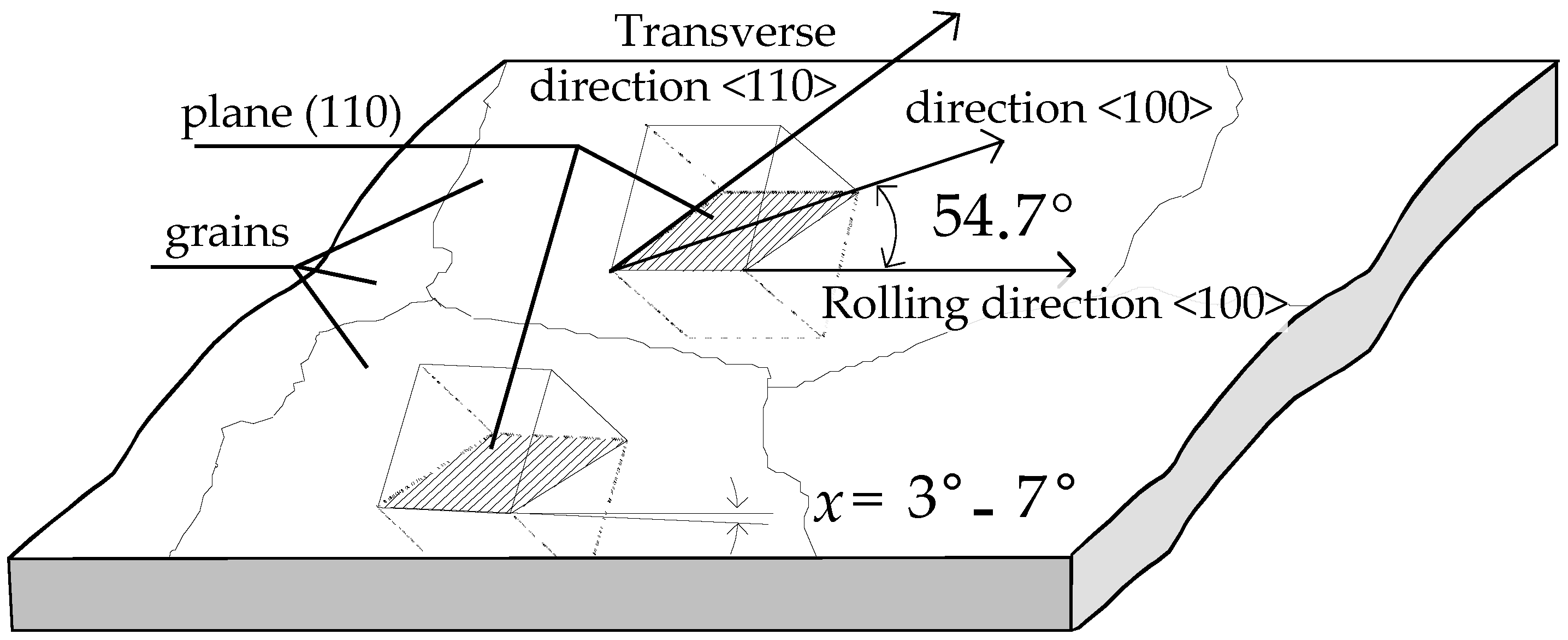
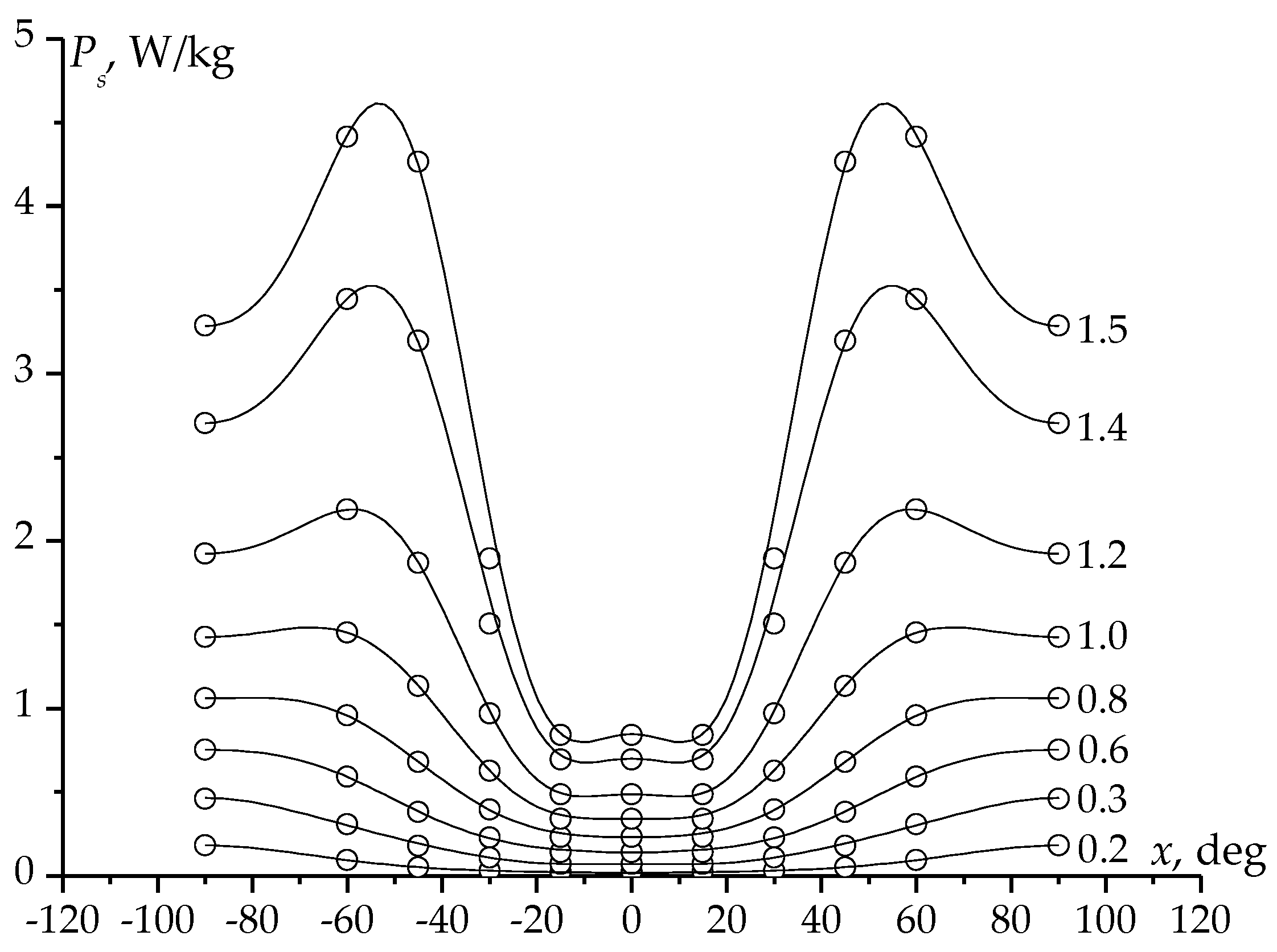
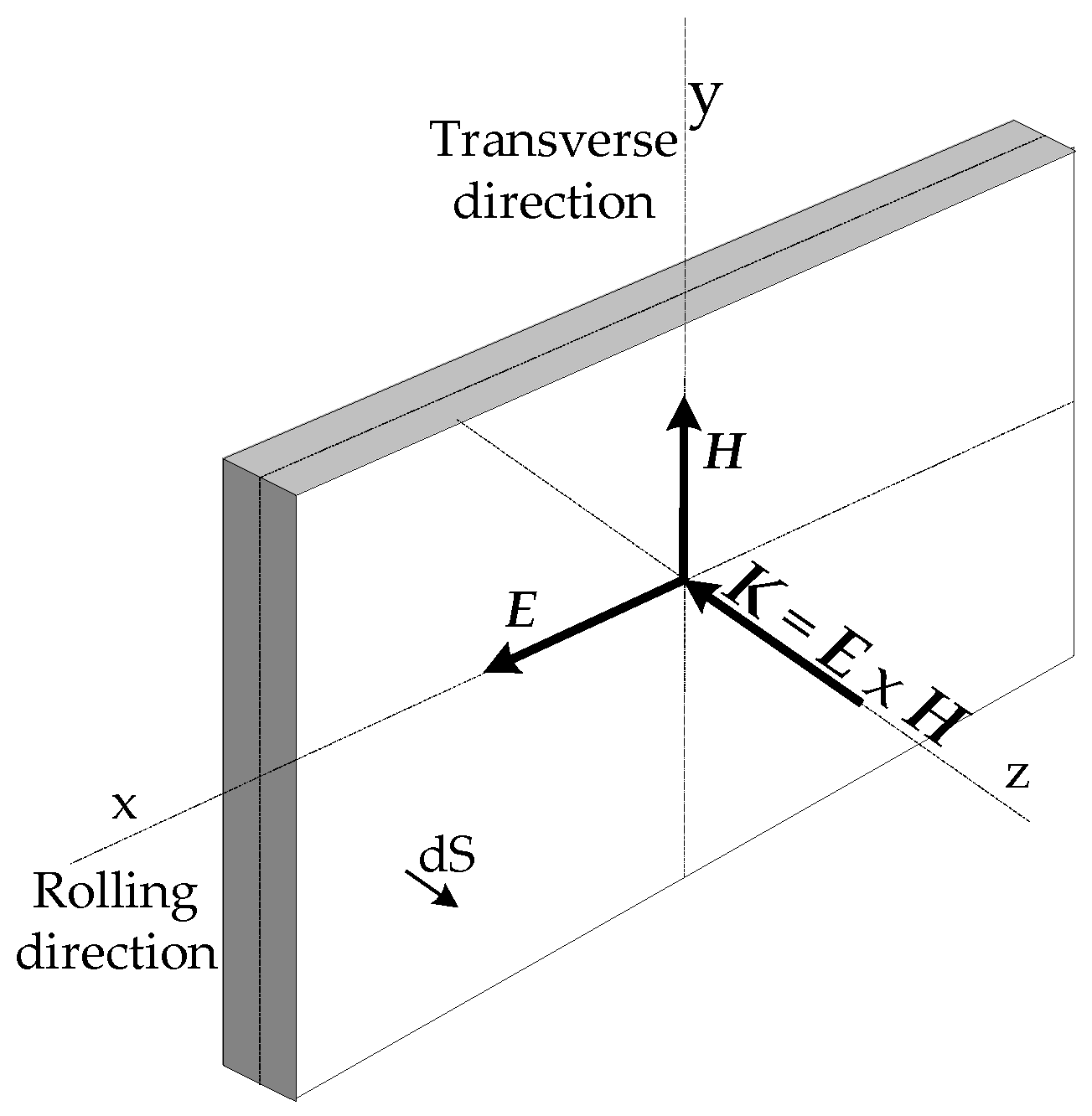
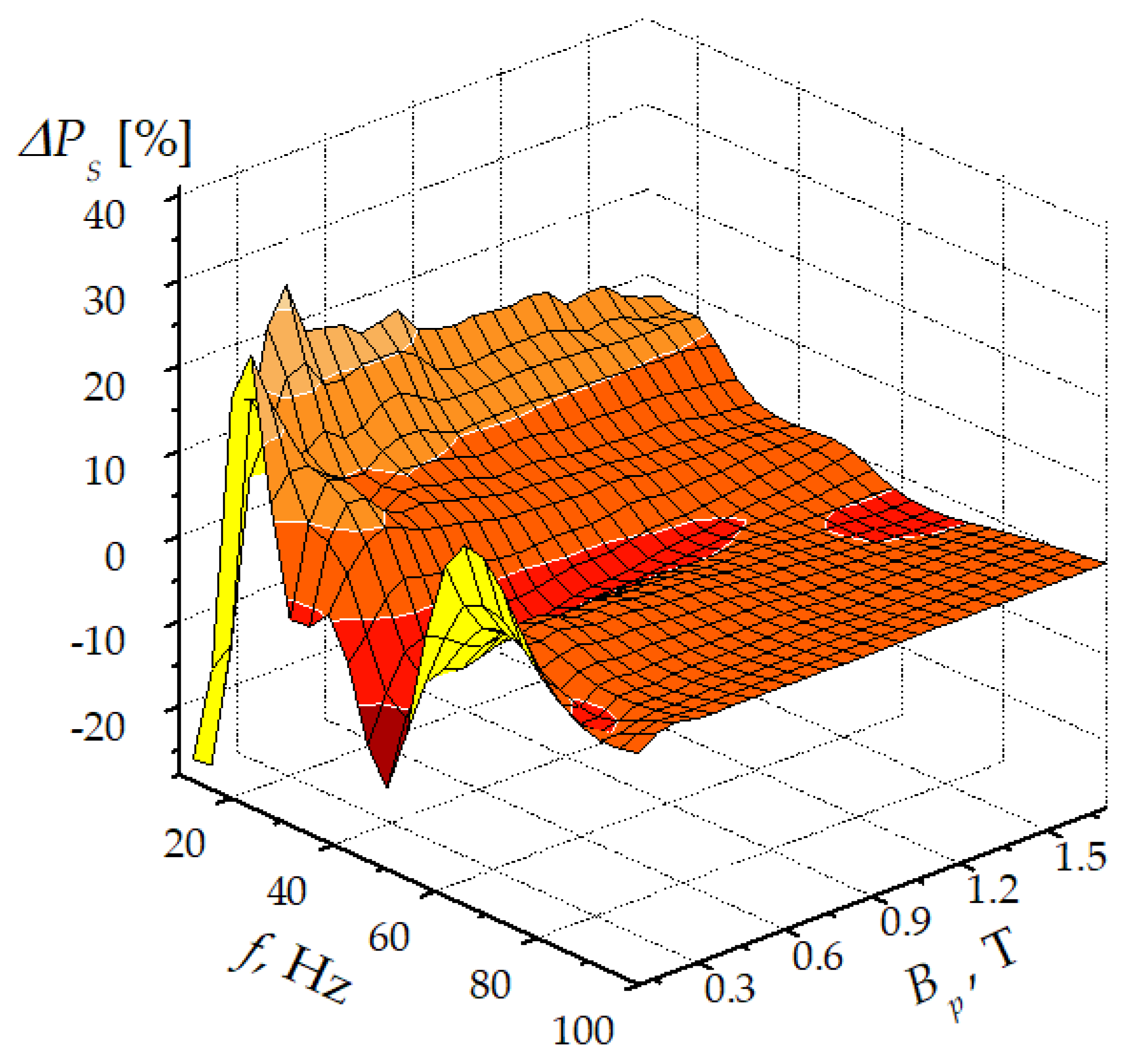



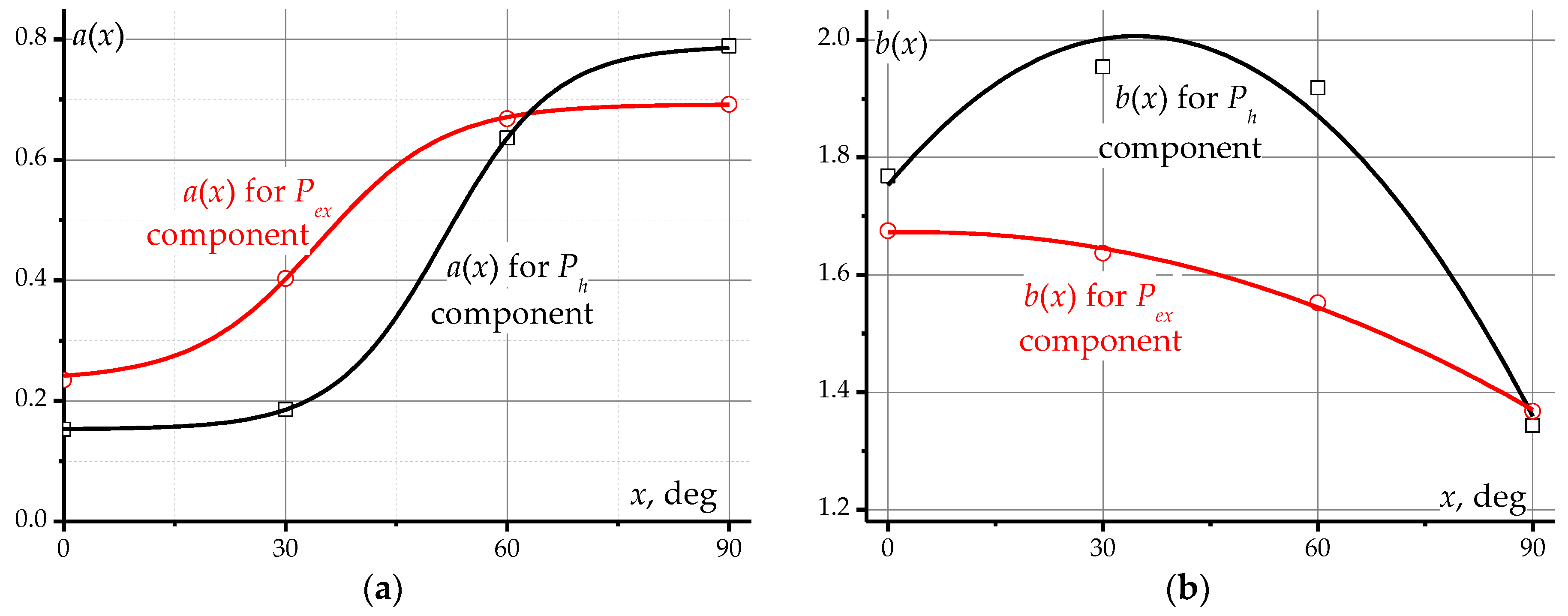

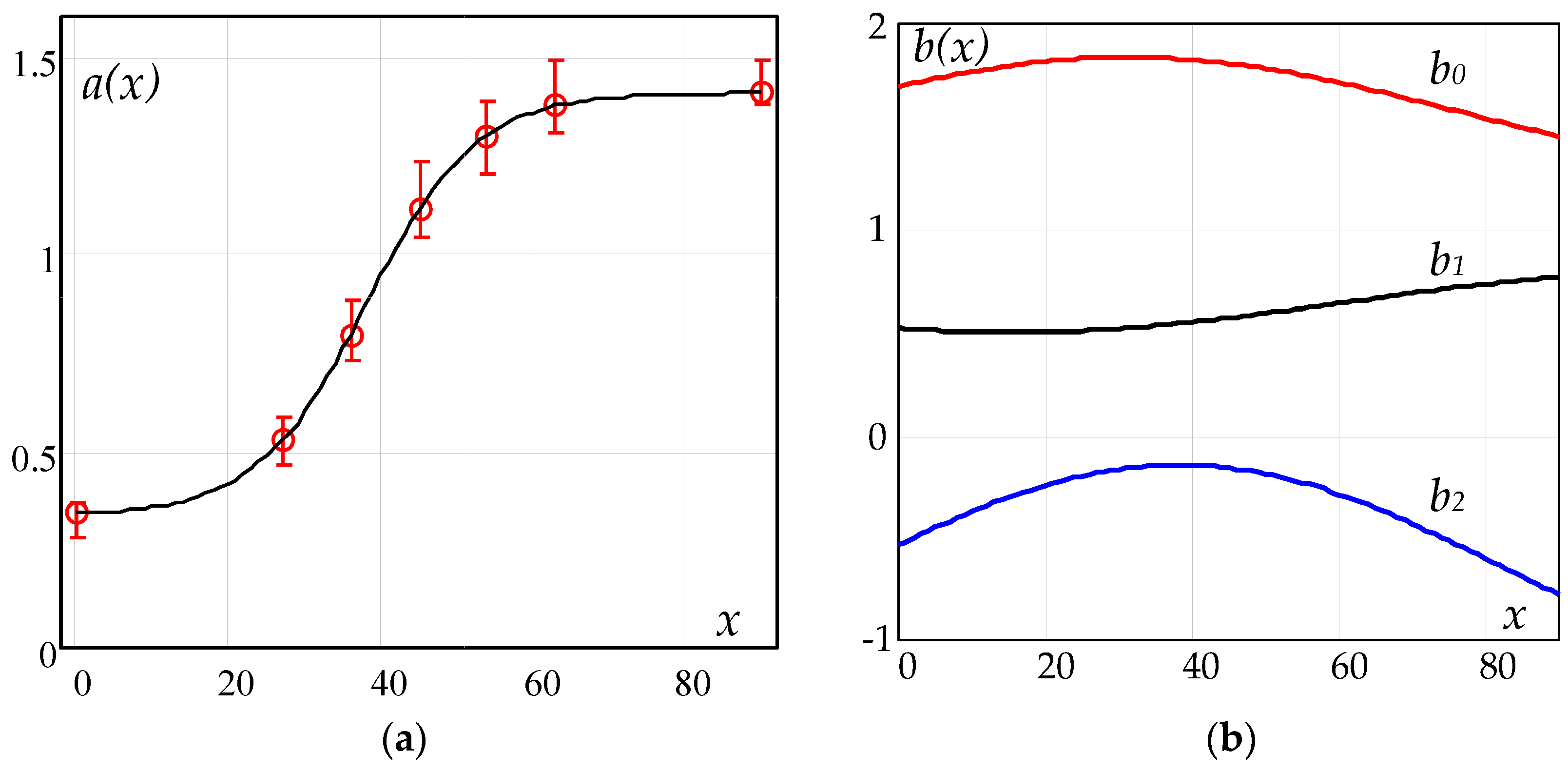
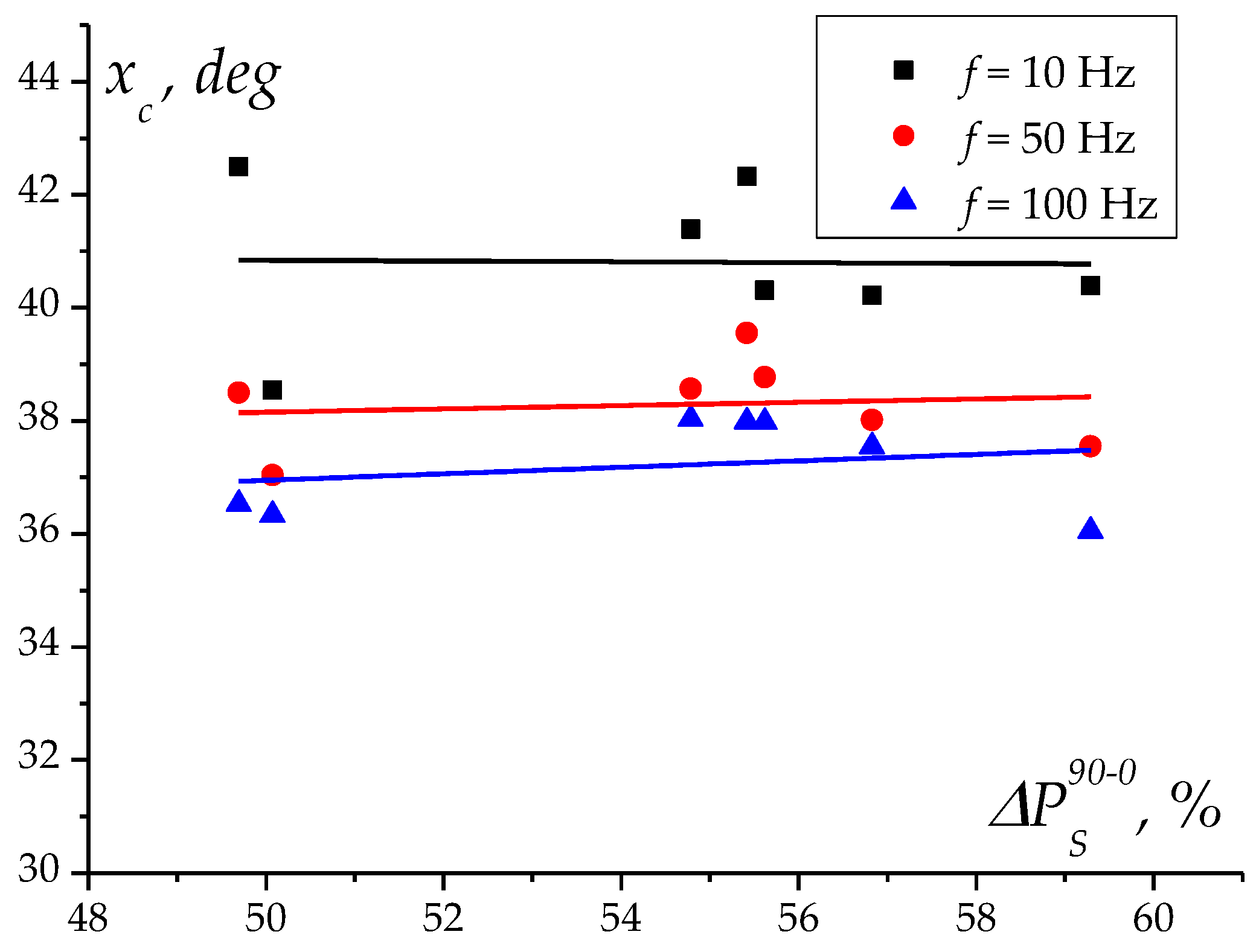
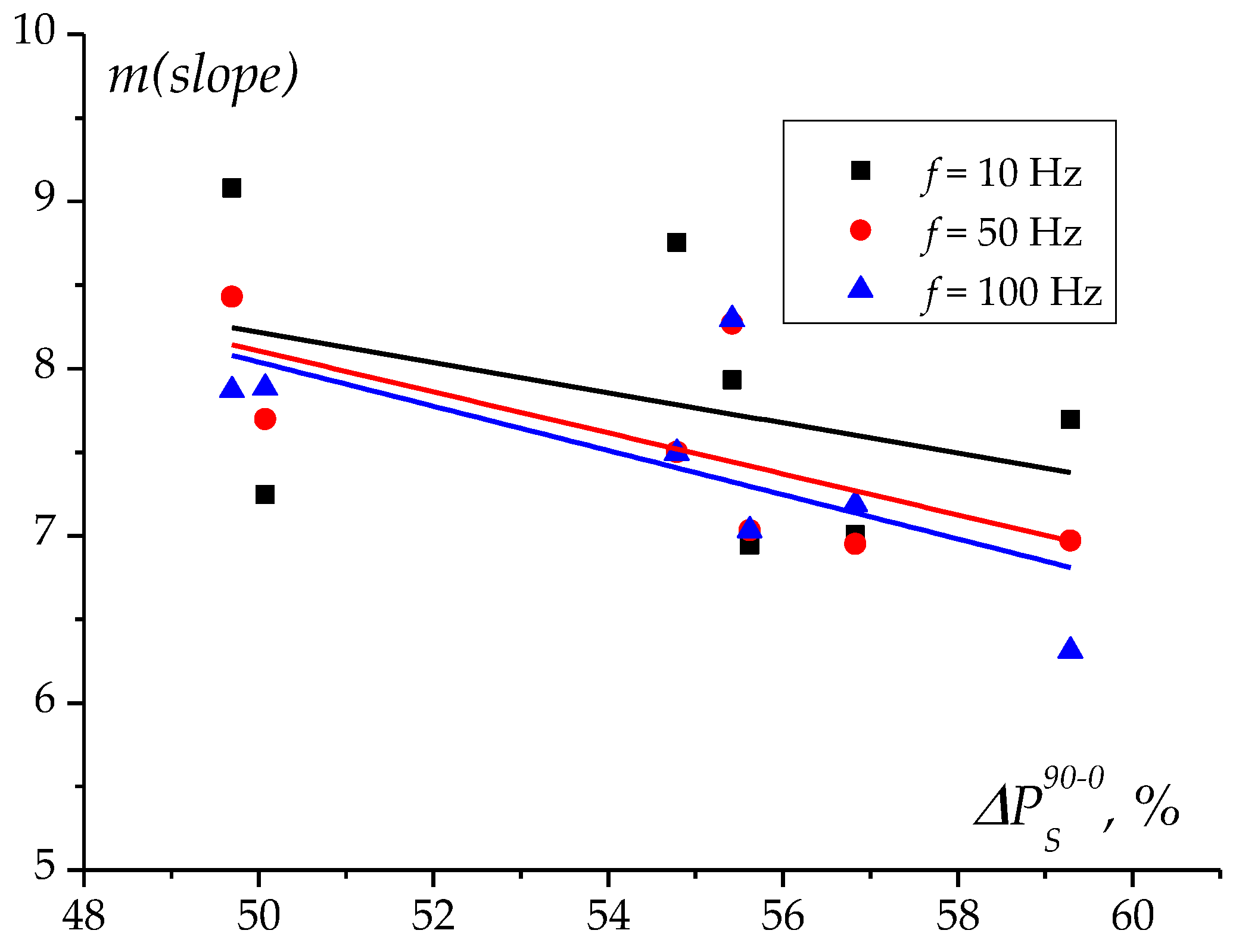



Disclaimer/Publisher’s Note: The statements, opinions and data contained in all publications are solely those of the individual author(s) and contributor(s) and not of MDPI and/or the editor(s). MDPI and/or the editor(s) disclaim responsibility for any injury to people or property resulting from any ideas, methods, instructions or products referred to in the content. |
© 2024 by the author. Licensee MDPI, Basel, Switzerland. This article is an open access article distributed under the terms and conditions of the Creative Commons Attribution (CC BY) license (https://creativecommons.org/licenses/by/4.0/).
Share and Cite
Pluta, W.A. The Effect of Magnetic Anisotropy on the Computed Specific Total Loss in Electrical Steel. Energies 2024, 17, 1112. https://doi.org/10.3390/en17051112
Pluta WA. The Effect of Magnetic Anisotropy on the Computed Specific Total Loss in Electrical Steel. Energies. 2024; 17(5):1112. https://doi.org/10.3390/en17051112
Chicago/Turabian StylePluta, Wojciech A. 2024. "The Effect of Magnetic Anisotropy on the Computed Specific Total Loss in Electrical Steel" Energies 17, no. 5: 1112. https://doi.org/10.3390/en17051112
APA StylePluta, W. A. (2024). The Effect of Magnetic Anisotropy on the Computed Specific Total Loss in Electrical Steel. Energies, 17(5), 1112. https://doi.org/10.3390/en17051112



